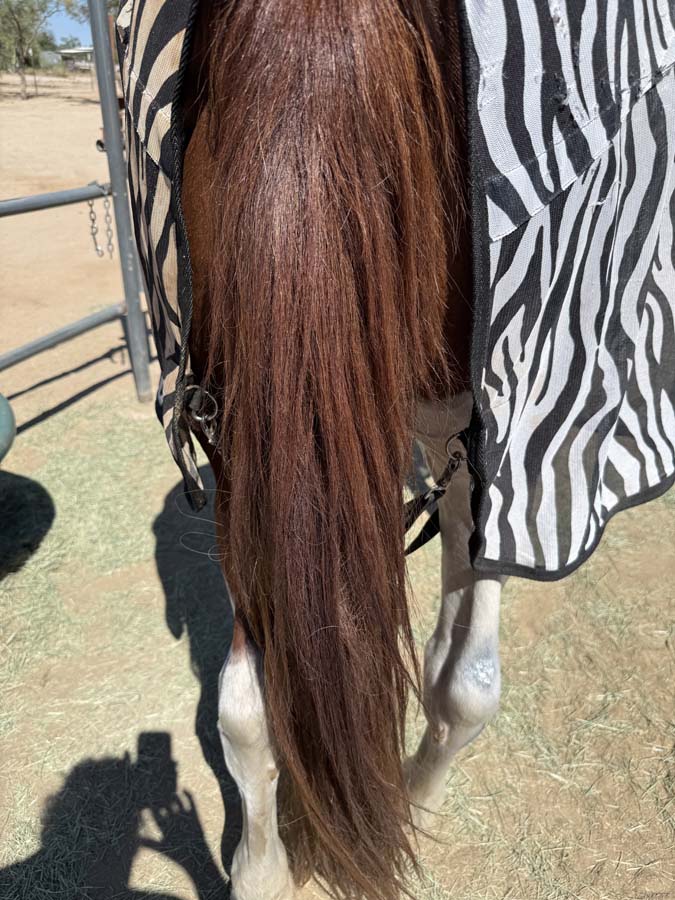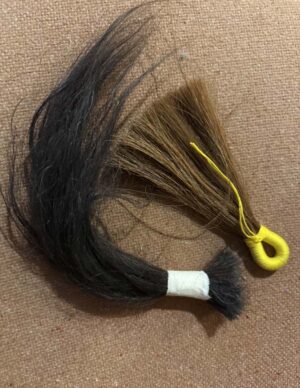The Language of the Horse Tail
In my new writing spot in my friend’s cabin in the mountains of Overgaard, I have a clear view of my horse in his stall. My trail horse, Poncho, is ¾ Missouri Fox Trotter and ¼ Paso Fino, and besides his lovely multi-colored body, he has a magnificent, impressively thick tail. His previous owner asked me to make sure his tail is cared for, and of course, I care for it along with all his other parts.

More Than Just a Fly Swatter
I’m surprised at how fast Poncho’s tail grows. Every few months I have to trim it to keep it from being long enough to walk on. I also leave it free-flowing so he can swish away the bothersome Arizona flies. I love watching the hair fluff in the air as he sends it in the direction he desires.
Poncho has also been known to swish at me when I’m dealing with his hooves. Fortunately, the movement is light and not done maliciously. What’s a tail for if you can’t use it to show a little friendly opinion to your human?
Tails have many uses beyond fly control:
- To Signal Bodily Functions: He lifts his tail, arched perfectly, when it’s time to poop, keeping it clear of the tumbling balls.
- To Flag Emotion: When he’s angry or scared, he raises it high to flag the danger. When life is good and he is feeling frisky, he’ll raise his tail and go galloping around the arena.
- For Communication: Interestingly, horses are the only member of the equine family with long tail hair, and they use their tails extensively for communication.
Reading the Equine Body Language
Tails tell volumes about a horse’s physical and emotional states, and herds discuss issues using their tails.
- Danger may be indicated with slightly raised tails, and stallions often indicate possible danger with raised tails and prancing.
- A vigorous swishing side-to-side usually indicates displeasure.
- A tightly clamped down tail may indicate a desire to buck or kick, but if a horse is standing still and moving its feet, the clamped tail may signal belly pain.
- And anyone with a mare in heat knows what she is seeking when she coquettishly raises her tail around stallions and geldings.
Horses even show friendship by standing head-to-tail and swishing flies off each other’s faces.
I enjoy observing the effectiveness of Poncho’s tail technique. A swish at a fly swirls the hair—a cascade of keratin. The brown tail nicely complements his long white neck and mane, providing him with attractive symmetry.
A Tail Never Static
I sit and watch him standing and swishing. Birds fly to the tree above him, and a squirrel scampers by. The neighbor walks by with his two huskies. The breeze picks up, and a few hairs ruffle.
Once on a trail ride, the horse I was with swished his tail at an ocotillo and ended up with a chunk of thorns stuck in it. Being a good friend, I tried to remove it, but he clamped his tail down. I was only trying to help! Eventually, he managed to swish it out, but I was worried he would flick his tail and hit himself with the thorns.
A tail is never static; it’s ever useful—a filamentous, ever-changing ballet. It can even be a remembrance of my horses who have passed on: Button and Napoleon.
Did you enjoy this peek into my life? As an author, biologist, and reptile enthusiast, my stories are often inspired by the wild beauty of the places I live and visit—from the Arizona mountains to the beaches of The Bahamas. My newest project, an animated film based on my character Curtis Curly-tail, brings the environmental messages of The Bahamas to life!
Be a part of Curtis Curly-tail’s animated adventure and help support iguana conservation!
To learn about our latest science-based children’s books and workbooks, to read our latest blog posts about reptiles, birds, cats, and gardening, in a variety of locations, and about how the books come to be, what inspires an author to write, and many more interesting aspects of the publishing business, fill in the box below and we will add you to our email list.
Thank you!





